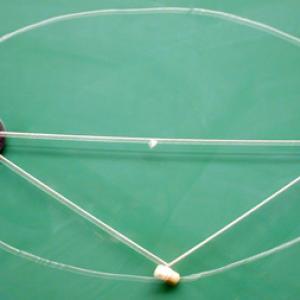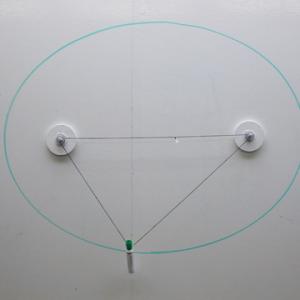College of Liberal Arts & Sciences
1L20.50 - Ellipse Maker
See also 1L20.50 in Mechanics.
In LR I and LR II just attach the ellipse maker to the magnetic chalk boards. The large donut magnets that are on the maker will limit the eccentricity that you will be able to achieve. In LR 70 you will have to use the portable white board and the magnetic attachments that are available. Chalkboards in that room are not magnetic.
- Barbara Rovsek, "How Eccentric Is the Orbit of the Earth, and Where Is the Sun?", TPT, Vol. 59, #6, Sept. 2021, p. 438.
- Thomas B. Greenslade Jr., "Using Physics to Solve a Mystery", TPT, Vol. 47, #1, Jan. 2009, p. 4.
- Jeffrey Prentis, Bryan Fulton, Carol Hesse, and Laura Mazzino, "Elliptical Orbit - 1/r2 Force", TPT, Vol. 45, #1, Jan. 2007, p. 20.
- Jorge Sztrajman and Agustin Rela, "Optical Property of the Ellipse Derived from Energy Conservation", TPT, Vol. 41, #4, Apr. 2003, p. 208.
- H. Richard Crane, "Simple Devices That Fascinate - But Only Some People", TPT, Vol. 31, #2, Feb. 1993, p. 120.
- S. D. Baker, "Short Visual Quiz on Ellipses", AJP, Vol. 53, #8, Aug. 1985, p. 790.
- W. G. Harter, "The Lenz Vector and Orbital Analog Computers", AJP, Vol. 44, #4, April 1976, p. 348.
- S-400, "Acrylic Drawing Aids", DICK and RAE Physics Demo Notebook.
- Tik Liem, "The Elliptical Wonder", Investigation to Science Inquiry, p. 312.
- Martin Gardner, "Draw A Perfect Ellipse", Entertaining Science Experiments with Everyday Objects, p. 56.
- Janice VanCleave, "How Far?", Astronomy for Every Kid - 101 Easy Experiments That Really Work, p. 60 - 61.
- Jim Glenn, "Elliptical Thinking", Scientific Genius: The Twenty Greatest Minds, p. 28.
Disclaimer: These demonstrations are provided only for illustrative use by persons affiliated with The University of Iowa and only under the direction of a trained instructor or physicist. The University of Iowa is not responsible for demonstrations performed by those using their own equipment or who choose to use this reference material for their own purpose. The demonstrations included here are within the public domain and can be found in materials contained in libraries, bookstores, and through electronic sources. Performing all or any portion of any of these demonstrations, with or without revisions not depicted here entails inherent risks. These risks include, without limitation, bodily injury (and possibly death), including risks to health that may be temporary or permanent and that may exacerbate a pre-existing medical condition; and property loss or damage. Anyone performing any part of these demonstrations, even with revisions, knowingly and voluntarily assumes all risks associated with them.

